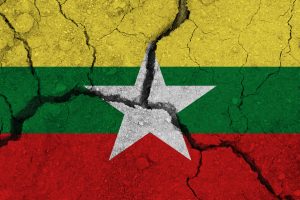It may be in the middle of a bloody civil war, but Myanmar potentially stands on the precipice of a new democratic awakening. Despite the immense suffering of Myanmar’s population in recent years, with recent successes of revolutionary forces combined with waning military control, there is a generational opportunity to reimagine an inclusive democratic state without the previous pacts between military and civilian leaders.
February 1, 2024 marked the third anniversary of the attempted military coup led by Senior General Min Aung Hlaing. The violent end to Aung San Suu Kyi’s National League for Democracy government has resulted in extended conflict, humanitarian crises, economic collapse and the breakdown of basic services.
More than 3 million Myanmar people are also internally displaced due to the conflict and instability.
Liberal Democracy as a Mistaken Talisman
For years, Aung San Suu Kyi was the beacon of hope for democracy in Myanmar. But, as Myanmar author Ma Thida suggests, for many Myanmar people the years before the 2021 coup were not “democratic” under Aung San Suu Kyi’s government, nor was there a clear road toward democracy. Rather, the country remained trapped within a “maze” created by the military where it held control of key levers of military, economic, and political power.
Indeed, liberal democracy has long held a talismanic quality in Myanmar politics where transition is almost always interpreted through the lens of democratization, rather than through other prisms such as nationalism, self-determination, or control of resources.
This can lead to an assessment of contemporary Myanmar as a struggle between liberal democratic revolutionary forces and an authoritarian military regime.
In reality, the forces currently opposing the military regime are extremely varied. Some, such as human rights activist groups and political parties, may have claim to democratic goals, others are primarily concerned with ethnic nationalism, and others still are simply striving for their own version of gun-wielding authoritarian power.
The interests of these groups are aligned only insofar as they are opposed to Min Aung Hlaing’s regime. This makes the narrative of democratic struggle in Myanmar far less cut and dry. And even where democracy is a stated goal, our research has revealed sharply diverging assumptions about the meaning of “democracy” itself.
Buddhist-inspired, leader-centric interpretations of democracy abound, as do more radical democratic goals. Words such as “human rights,” “federalism,” and “accountability” all have diverging meanings attached to them depending on the varied interests of political parties, ethnic armed groups, activists and local civil society organizations.
Assuming that liberal democracy is a shared goal even for all Myanmar’s “democratic” actors would be a grave mistake.
New Thinking About Democracy
However, the attempted coup and subsequent intensification of conflict has, in some ways, unlocked new ideas about Myanmar’s democratic future.
The restrictive 2008 constitution was put in place by the military as part of its plan to partly transfer power to civilian leadership and this presented a major obstacle to deeper reform. With provisions for military quotas in parliament, centralized decision-making systems, and immense powers for the military’s commander-in-chief, the 2008 constitution cast a shadow over any discussion of democratization.
The attempted coup and revolution, however, have dramatically shifted the political landscape, to the point where the 2008 constitution no longer holds any political salience outside of the hard core of the military regime. This rejection of the 2008 constitution and the revolution against the military has opened new possibilities for imagining a post authoritarian Myanmar democracy.
Most importantly, there is now widespread consideration of Myanmar federalism outside the constraints of the 2008 constitution. The longstanding grievances of ethnic minority groups in border areas are now more widely understood by members of the Bamar majority, mostly because the brutality of the Burmese military has now also been experienced by communities in heartland areas.
In military terms, many ethnic revolutionary armies have a stronger hand now than they had prior to the coup, so in some ways Bamar political leaders in the shadow National Unity Government in exile had no choice but to imagine a more inclusive and federal Myanmar.
Whatever the motivation, a reimagining of a federal democracy in Myanmar has clearly been catalyzed by the coup and the intensification of conflict.
In practical terms, the loss of territory controlled by the military government, and the collapse of effective government services in areas they do control, has also left spaces for a plurality of new arrangements of local governance. Governance and service provision structures are being adapted and reformed by the National Unity Government and ethnic revolutionary organizations but also myriad other groups.
In “liberated areas” in Sagaing region and Kayah state, for example, there are innovations in governance and new experiments in using federal principles at the local level. Local civil society and community organizations, from national to township and village level, are also playing a key role in mediation and coordination not only over distribution of humanitarian aid but also in local governance.
These new practices and forms of local governance are varied and by no means all democratic in nature, yet they have created an opportunity for reenvisaging and redesigning local governance in the country, in a way that has largely been impossible since independence from Britain more than 70 years ago.
This article is part of an Asia Institute/Asialink series on democracy in Southeast Asia to accompany the University of Melbourne’s upcoming Southeast Asia Oration to be delivered by Mr. Pita Limjaroenrat MP, Member of the Thai House of Representatives and Former Leader of the Move Forward Party, on July 4.
Published under Creative Commons by 360info™.

































